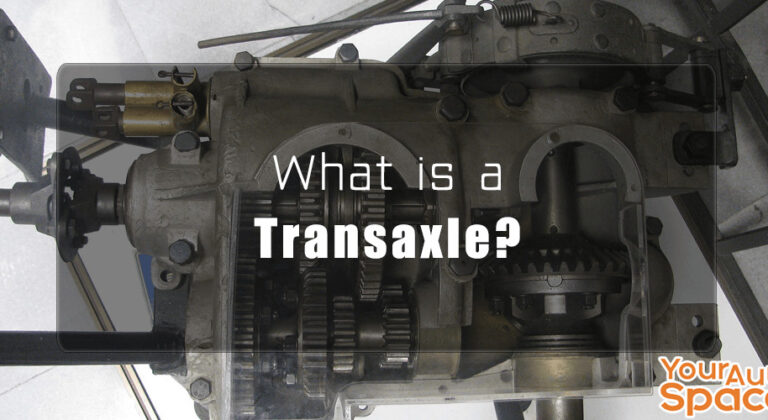
A transaxle is basically a complex machine in your car, which brings together final drive components such as a differential and a transmission. Therefore, this part is able to drive the axles without the need of any other parts. This is especially helpful in front-wheel drive vehicles in which CV axles could be directly plugged in the unit, even though transaxles are also applied rear-wheel-drive and front-engine applications.
Transaxle Definition
The term “transaxle” is a combination of two different words: transmission and driven axle, which basically describes what are comprised of this unit and what it performs. Generally speaking, it helps to transmit the power from the engine of your car to the drive wheels through the driven axles. Also, it allows a driver to adjust the gear ratios, which is the main purpose of a transmission.

All of this is, of course in American English. The term “transmission” in British English basically refers to all of the different parts in the drive train, including both the differential and the transmission. The most striking difference between a transmission in British and a transaxle is that the latter is designed with both a differential and a transmission in a single area.
History of The Transaxle
Although the transaxles have been used widely in the recent years, its origination started with the history of automobile industry. The first transaxle models were applied in rear-wheel drive cars that contained front-mounted engines. The De Dion Bouton was one of the earliest models as it was introduced in 1898. This the trend did not reach the US till the 1960s when the Chevrolet Corvair was launched with a rear-wheel-drive and rear-engine transaxle. Beginning in the 1980s, a couple of automakers changed to transaxles for 4-wheel-drive cars, including Audi’s Quattro system in 1981, Ford, Mitsubishi, and Nissan’s GT-R in 2007.
The Popularity of Transaxles
Even though the history of the transaxles are full of models where the drive wheels and the engine are located on the opposite sides of the car, this technology is very popular in the reverse configuration. In addition, vehicles with the engines and the drive wheels on the same side (rear or front) almost always utilize a transaxle.
An early model of this configuration was the Beetle of Volkswagen with its rear-wheel drive, and rear-engine configuration, but the ubiquity of this design has increased in the last few years. These days, a large number of front-wheel drive vehicles in Japan and the US use transaxles. And this configuration is particularly popular in smaller car models.
Transaxle Orientation
A transaxle can be directed either in a diagonal (transverse) or longitudinal fashion. Most of the transverse transaxles are applied together with transverse engines, which are very popular in the majority of modern front-wheel drive cars. In general, this is a configuration that locates the whole drive wheels and the drive train in the front end of your car.

On the other side, a lot of rear-wheel drive cars use longitudinal engines, along with a drive train and conventional transmission. But the rear-wheel drive cars with transaxles, which have either rear- or mid-engine layouts do utilize transverse-mounted transaxles. For those engines which are located in the rear side, the overall configuration is quite similar to the layout of front-engine.
Parts of a Transaxle
Depend on design and model, the structure of a transaxle can be very different from one brand to another. But they often have in common a couple of components such as a differential and a transmission. Some of the main components include:
- Bearings
- Gears and clutches
- Shafts: counter, idler, or input
A transaxle, of course, contains these elements in different configurations and amounts than either a differential or a transmission. This device does not allow the drivers to adjust gear ratio (the purpose of the transmission), but it is also able to distribute the torque to your drive wheels.
Transaxle Failures
As a transaxle is designed with a transmission, a differential, and other drive parts, there are a lot of possible failures that you need to take into consideration. A couple of signs to keep an eye, nose, or ear for include:
- Slipping gears
- Drag if coasting
- Loud noises (clunking, rumbling, or whining) when running from a complete stop
- Excessive shaking in shifting gears
- Noise in the transmission, particularly in neutral
- Burnt transmission fluid
To sum up, it is important to check the possible failures before or as soon as they occur because you are dependable on a transaxle to get the power to your drive wheels from the engine of your car. Therefore, it is a good idea to examine your fluid on regular basis and take your car to an experienced mechanic at the first sign of the problem.
I have a 2008 AWD Chevrolet Equinox 3.4 litre engine, 5-speed automatic transmission, with 93,000 kilometers. I recently had the transmission oil changed (not Flushed). Besides regular oil changes and transmission oil change,& brake fluid checks, what other components should be checked for oil/lubrication? Thank-you kindly.
Make sure to the change the blinker fluid regularly.